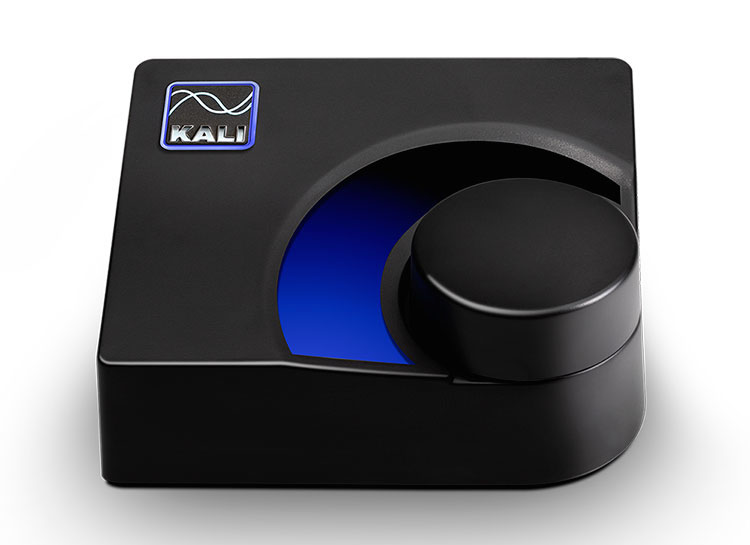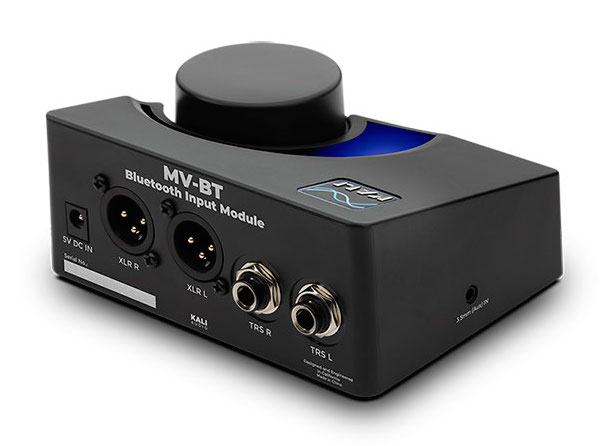New Gear Review: MV-BT Bluetooth Module by Kali Audio

Kali Audio offers an attractive Bluetooth solution with the MV-BT. Can it earn a spot in your listening space?
It was only 2018 when speaker manufacturers Kali Audio emerged onto the scene with their debut product line, the Project Lone Pine 2-way studio monitors. With a promise to expose all of the intricate details of your mix, these speakers struck a chord with those who seek reliable playback yet don’t want to break the bank. This debut established a solid reputation for Kali right out of the gate.
The company later introduced their first 3-way speaker, the IN-8, followed by the Project Watts series featuring the WS-12 subwoofer.
Now, the southern California based company is challenging you to ditch the aux cable with their first non-speaker offering, the MV-BT: a desktop bluetooth receiver with balanced outputs that is sure to prove useful in your studio, or even your everyday listening rig.
With the explosion of streaming culture, the aux cable is being passed around writing, production, and mix rooms now more than ever. It seems everybody’s got a reference for something on-hand, at the ready. But aux cables often don’t reach every corner of the room, and the wear-and-tear happens fast, in my experience. I’ve soldered new 1/8” TRS jacks onto many an RCA cable.
It’s time for a solution, and quite frankly I’m surprised the market isn’t saturated with more handy little offerings like the MV-BT. Let’s see if this little black box can find a spot in your production space, or even your living room next to your receiver.
Features and Use
The first thing you’ll notice about the MV-BT upon powering it up is that it’s sexy. It sports a black matte finish and a sleek blue LED volume indicator, along with a backlit Kali Audio logo button for pairing. Its footprint claims only 5×4 inches of your desktop, and visually it will appear just as natural situated near your central monitoring controls as it would in an out-of-the-way corner.
As for connections, the MV-BT offers two pairs of balanced outputs on its rear panel (TRS and XLR), and a somewhat inconspicuous 3.5mm aux input on the left side. Other than a 5v DC power input, that’s it! The volume knob is big (2 inches in diameter), and weighted for an extra feeling of quality—because who doesn’t like an authoritative volume control? The unit employs high quality codecs for maximum clarity—AAC for iOS devices, and aptX for most others.
In real life applications, using the MV-BT couldn’t be a more simple affair. Kali includes a visual diagram (reminiscent of IKEA furniture building instructions) on the inside-top flap of the box which walks you through first-time pairing instructions. It’s dead simple: hold the backlit Kali Audio button in the upper left-hand corner of the MV-BT for two seconds, and it should appear in your device (as “Kali MVBT”). Connect, and you’re done. And when powering the unit off and back on, it re-pairs fast (literally within a second or two) if your device is properly set.
In a pandemic world, the foot traffic in my studio consists of me and me alone, so there’s not a lot of referencing from multiple parties feeding my speakers here at the moment. But sure enough, when there are a few heads in the room buzzing with ideas that they’d like to play aloud, asking them to pair with the MV-BT instead of passing around an aux cable that’s connected to an iPhone dongle—when people forget the speakers aren’t muted—will be an absolute pleasure. Ever met anybody that likes the sound of a cable getting pulled from a live set of speakers?
Oh, and is it a given to highlight the fact that the difference in sound quality of the MV-BT, codec-wise, compared to any other bluetooth connection I’ve used, is negligible? Feed a good set of monitors with it, and you will be very happy with the sound, I promise.
To Be Critical
It’s hard to fault the MV-BT for anything, really. The little box, once situated in my rig, has given me zero issues, looks rad, and has only made my life easier.
I wasn’t sure whether the enclosure of the MV-BT would be made of metal or plastic, and upon unboxing I found it was the latter. In my particular setup, the unit shares desktop space with a nOb controller (wooden enclosure) , and a BOSS footswitch that controls my sub (metal enclosure)—so the MV-BT does weigh in the “lightest” of the bunch. However, this unit is designed to be stationary and will not receive any kind of heavy tactile use, so there’s really no need to make it road-ready. I can’t say this is a deal breaker.
To this point, Kali has also since noted that if the MV-BT were to employ a metal enclosure, it would act as a Faraday cage, effectively blocking the electromagnetic field of the Bluetooth antenna. And thus: plastic for the win! You learn something new every day.
My only other quibble regarding actual use of the unit is that after being powered off and back on, your previous volume setting is not retained. Though probably a plus for some setups, I am running the unit through a monitor controller which I prefer to feed with 100% volume output from all sources, and the MV-BT defaults to somewhere around the 50% mark. Though not a huge inconvenience to crank the volume knob for the first listen of the day, a stored volume setting would be a welcome addition in my particular rig.
Summing it Up
It’s 2020, and people want and expect to live in a world without cables. In a lot of ways, we’re already there. Kali Audio has got a winning idea here with the MV-BT. And frankly, I’m surprised that there isn’t more competition in this little corner of the market—barring one somewhat similar, yet far less sexy piece from Denon.
Priced attractively at $99, the MV-BT can appeal to not only engineers and producers like myself who often juggle multiple devices feeding their playback rig, but also to your average music listener who’s got a home entertainment system employing a receiver. Maybe the vinyl aficionado couldn’t find a particular hard copy of a record and needs to call it up on Spotify—just pop over to the MV-BT. I will surely not be unplugging it from my rig anytime soon.
Please note: When you buy products through links on this page, we may earn an affiliate commission.








[…] It was only 2018 when speaker manufacturers Kali Audio emerged onto the scene with their debut product line, the Project Lone Pine 2-way studio monitors. With a promise to expose all of the intricate details of your mix, these speakers struck a chord with those who seek reliable playback yet Read more… […]